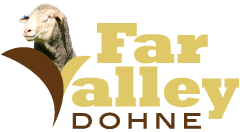by Cameron McMaster
Information suppplied by Daan Slabber
The remarkable productivity of the Dohne is highlighted by results achieved by Slabber Farms, Malmesbury - confirming the outstanding dual-purpose features of our Breed.
A lamb marking percentage of 196% in the Milmatha Dohne stud this year prompted me to visit Daan Slabber, manager of the stud in which he and his brother Johan are partners. I wanted to discover how this was achieved and if there was any special recipe for such an excellent result.
The answer was much as I expected - there was no magic formula - just the high reproductive potential of the Dohne and sound management to express this to its maximum. No artificial methods were used. On the contrary, Daan believes that his stock management should be as natural as possible.
The stud runs on the farm Kleigat situated between Malmesbury and Darling in the Swartland of the Western Cape - a winter rainfall region. It is part of a mixed farming enterprise which combines stud and commercial Dohnes with grain and wine production. The sheep run on pastures consisting of medics and volunteer oats, wheat and barley as well as on stubbles in the summer.
Ewes are flushed before mating with a home-mixed lick consisting of oilcake, molasses and grain siftings together with 100 gm of lupins per day. Vitamins A and E are given two weeks prior to mating. Natural single-sire mating at a rate of 3% rams for 34 days is practiced. Rams run on normal pasture before mating, with no special supplementation. Ewes continue to receive the lick during pregnancy, and shortly before lambing this is supplemented with energy in the form of small amounts of maize grain to prevent pregnancy toxaemia.
In April this year 232 lambs were marked from the 118 ewes that were mated - a lambing percentage of 196.6%! Lamb survival was excellent and although they were all multiples, a mortality of only 5% between birth and weaning was recorded.
Outstanding reproduction rates were also achieved in the commercial flock of 1300 ewes where 141% lambs were marked in 2005. This is the result of consistant strict selection for reproductive performance in the young replacement ewes. They are mated separately at 10/11 months of age at body weights of at least 45 kg. They lamb in August when a lambing percentage of 80% is the norm at this age. Only those young ewes that successfully rear lambs qualify for the commercial flock. Lambs are weaned early and the ewes that qualify are mated for a second time in the main flock in November.
The growth rates and brilliant slaughtering results were an added spinoff which confirm the unbeatable performance of Dohnes in a commercial sheep production system. Weaning stress is avoided by marketing the wether lambs directly off their mothers at between 100 and 140 days of age when liveweights of 40kg and more are easily reached. A spinoff of marketing at this early age is the high dressing% achieved at slaughter. By September 600 prime wether lambs had already been marketed with an average carcass weight of 19 kg. The majority graded A2 and some were already too fat!
The commercial flock is registerd as a Foundation Flock at the Dohne Society. The top commercial ewes qualify to be promoted to the Stud. After weaning, ewe lambs are classed and the culls marketed with the wether lambs. From the approximately 1000 young flock ewes available each year, the best 300 are performance tested on the basis of which the highest ranking are selected for mating for the final test that qualifies them for promotion to the Stud. The final test is reproductive performance - they must rear good lambs at this age to qualify. On this basis approximately 60 (±6%) young ewes are promoted to the Stud annually. It is very likely that the strict criteria in terms of both production and reproduction traits that replacement ewes have to meet, are the secret of the high fertility of the Stud.
The Dohnes are shorn every 6 months - in mid-April and mid-October - and produce an average of 6 kg wool per annum. The average fibre diameter of the mature ewe woolclip is 21 microns. Wool from the young rams and ewes tests 19 microns at 12 months of age.
The outstanding productivity of their Dohne Stud and Commercial Flock, together with current low grain prices, has resulted in a decision to increase sheep numbers in the Slabber farming enterprise. The goal is at least 2000 flock ewes and enough stud ewes to meet the rapidly increasing demand for Dohne rams. An annual on-property Ram Sale is planned in the near future.

